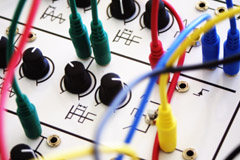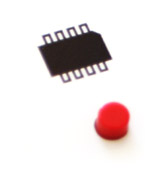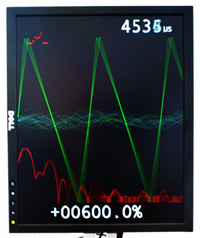State Zero, Patching
 Outwardly similar in operation to conventional voltage controlled modular synthesisers, interconnections between the modules of the State Zero synthesiser are completed using the included physical 3.5mm cables. The front panel represents one voice and all 8 notes of polyphony mirror the same configuration. Due to the polyphonic and digital nature of the synthesiser it is not possible to directly interface with analog control voltages in the patchfield, rather analog signals must be brought in/out on the DC coupled stereo inputs/outputs at the rear.
Outwardly similar in operation to conventional voltage controlled modular synthesisers, interconnections between the modules of the State Zero synthesiser are completed using the included physical 3.5mm cables. The front panel represents one voice and all 8 notes of polyphony mirror the same configuration. Due to the polyphonic and digital nature of the synthesiser it is not possible to directly interface with analog control voltages in the patchfield, rather analog signals must be brought in/out on the DC coupled stereo inputs/outputs at the rear.
 When saving a voice all the routes are stored to memory for instant recall later without the need to reinstall the cables. Once recalled it is then possible to overwrite the saved routes simply by installing cables for the new routes, normalling of the connection is accomplished by saving the desired setup to memory location 0 which is automatically loaded on power up and further normalled schemes could be saved to regular memory locations as needed.
When saving a voice all the routes are stored to memory for instant recall later without the need to reinstall the cables. Once recalled it is then possible to overwrite the saved routes simply by installing cables for the new routes, normalling of the connection is accomplished by saving the desired setup to memory location 0 which is automatically loaded on power up and further normalled schemes could be saved to regular memory locations as needed.
 All signals within the synthesiser operate at full audio rate and are freely patchable from any source to any destination, scaling is volt/octave for frequency and rate destinations and linear for all others. Midi data is decoded into note/gate/velocity signals along with pitch bender and modulation wheel continuous controllers, or the two DC coupled analog inputs can accept CV or audio data should the need arise. Each parameter of every module is a pair of bipolar controls being the offset and modulation amounts, having a modulation destination for every parameter at full sample rate provides unparalleled flexibility and modulation possibilities.
All signals within the synthesiser operate at full audio rate and are freely patchable from any source to any destination, scaling is volt/octave for frequency and rate destinations and linear for all others. Midi data is decoded into note/gate/velocity signals along with pitch bender and modulation wheel continuous controllers, or the two DC coupled analog inputs can accept CV or audio data should the need arise. Each parameter of every module is a pair of bipolar controls being the offset and modulation amounts, having a modulation destination for every parameter at full sample rate provides unparalleled flexibility and modulation possibilities.
 Integrated in the instrument is a 3 channel oscilloscope with separate autoscaling timebases for the stereo outputs and the primary channel. This primary channel follows the patching and displays the signal present on the last cable to be moved or added, along with an octave scaled spectral analysis. The included 1024x1280 monitor shows these traces along with knob values, a stereo X-Y plot, and period measurement of the primary channel.
Integrated in the instrument is a 3 channel oscilloscope with separate autoscaling timebases for the stereo outputs and the primary channel. This primary channel follows the patching and displays the signal present on the last cable to be moved or added, along with an octave scaled spectral analysis. The included 1024x1280 monitor shows these traces along with knob values, a stereo X-Y plot, and period measurement of the primary channel.
